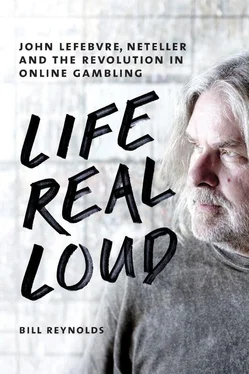“Except for the Americans, you mean,” I say, correcting him.
“Well,” he replies, “there are ways around that.”
There are a lot of online businesses out there in the world now, he tells me. It’s not like 1999. Every company needs to do business online. Some companies — small companies, say — might be run by people who are attracted to the idea of jacking up their revenue intake a bit and are open-minded to a little side action. They might even need a little extra to stay solvent. Say you’ve got a hair product website or old-school shaving supplies website or designer florist website. Whatever it is, it’s a legitimate business. It’s established. People buy stuff and you send it to them. Fulfillment. Well, what if someone comes along and says to you, “Hey, how’d you like to boost sales steadily over the next year or two?” You might say, “I’m listening.” They show you how to run online gambling transactions through your company as hair-product transactions or shaving-product transactions or flower-arrangement transactions — whatever. Over the next several months, you double and then triple your business. Your business looks like it’s successful and growing, and, indeed, it may be trending upward all on its own, but it’s being assisted by online gambling transactions.
And, well, you’re not the only guy who’s been approached, are you? They’ve got a whole bunch of guys like you, all guys who would love to make a little extra dough. You might think this a little outlandish, a little nickel-and-dime, a few too many hands on the take, a few too many finks who can talk, but it can be done.
As I listen to the chauffeur’s disquisition I’m thinking, you know, the DOJ decided the computerized system John and Steve invented for transferring bettors’ cash amounted to money laundering and racketeering. Once the locking pliers were firmly applied to them, the guilty plea was a big step down from money laundering and racketeering. Still, they were tailed for six months and then arrested for those offenses. I’ve never seen any evidence to suggest there was in fact any real money laundering going on. Neteller never hid anything it did, and was upfront about its risks in the American market. But this stuff the chauffeur’s telling me? Oh yeah, that definitely smells like something you’d call money laundering.
The chauffeur also claims Western Union remains involved in the gaming world, as does Visa. Actually, with Visa it’s a little more than that. He figures about twenty percent of all U.S. credit cards are still used for gambling. And when feds come around asking questions, Visa replies: Hey, it’s not our job to figure out what each legal cardholder is spending his money on. Visa might have a point.
The chauffeur, Tony, and I head east down Highway 27 into the core. The Del Rey is located on the northeast corner of Avenida 1 and Calle 9, one block southeast of Parque Morazán. The park itself has the Templo de la Música, once a center for political speeches but now a band shell for symphonic and popular music concerts; the Monumento a Simón Bolívar, the Venezuelan political and military visionary who brought independence to many Latin American countries; and the Monumento a Julio Acosta, president of Costa Rica 1920–24. But I’m not here for rabble-rousing or the symphony; I’m here to see what John saw ten years ago when he met with bookies to pitch Neteller at the Del Rey and other bricks-and-mortar gambling houses, or when he hung out with them at places like Nicole Night Club over in the Zona Roja (the red light district).
The hundreds of middle-aged men inside the building might be here for the gambling or the drinking or the pool. The Blue Marlin Bar looks like a combination of oversized suburban rec room and generic sports bar. There is a smaller room called the Little Marlin that we don’t go into. Across the street and across the parking lot is Key Largo, run by the same people who own the Del Rey. It’s a smaller joint with a live mariachi band on one side and basic bar with pool table on the other. They attract the same two depressing demographics — old men and young whores. Moving in the Del Rey is like worming through patches of fans at an oversold club show. Crowded in the gambling rooms, crowded at the bar, it’s difficult to find space to breathe. The pros make repeated attempts at eye contact. In one room, the gambling looks intense. Once we order beers I say, “Looks like any American or Canadian sports bar, except guys get to gamble and play poker.”
“Yeah,” Tony says, “except it’s a whorehouse.”
Young women, still girls basically, take their marks upstairs and pay the club a fee for using the rooms. Girls look up at me and say hi in sweet, quiet voices. One girl puts her hand on the middle of my back and rubs me in a clockwise motion and says, “Hi, want a good time?” That’s as forward as they get. Ten years ago, the girls would have acted differently, and that’s what John was counting on, his little joke, when he said I had to go to Costa Rica to experience what he had experienced — young women grabbing your testicles, not rubbing your back, when you entered the premises.
No, not like the old days, the chauffeur says. When you walked into the HDR then, it was like “fish in a barrel.” You were the fish, as in hold on to your wallet. Men everywhere, older men, old men, falling-down old men — well okay, I only saw one elderly gentleman in a cowboy hat fall off his high-back stool, literally right over, slam, onto the floor: three pros moved in, helped him up, their quarry near incapacitation and capitulation — all gauged on a scale of one to ten as marks.
No matter, the girls figure out I’m not there for a business transaction. To them I’m just a voyeur. There are about four hundred men to one hundred hookers, so the odds for them are good. If you go to the washroom, you walk by dozens lined up along a railing. Prostitution is legal in Costa Rica. Sex tourism is big business. These old guys, they tell their wives they’ve gone on a fishing trip. They spend at least one day going through with that charade so they can send back the pictures or post them on Facebook to prove it. The rest of the trip it’s whiskey, women, and song. Meranda says the rooms rent for ninety-nine a night. “Can you imagine, when you know what goes on in those rooms?”
“The HDR,” Tony says, “it’s got to be the most profitable business in San José.”
We hang out at the Del Rey for about forty-five minutes, at or close to the bar. Swarms of hookers don’t bother us much after initial contact. The chauffeur takes off and circulates. I begin to sense, maybe falsely, that the reason Tony has joined us tonight is that they might want to look for action together. This thought makes me uneasy. I don’t want to come across as a voyeur, yet here I am with my notebook in hand, looking like the king of stupid. I can’t open it and start writing, I’d look like a narc or a dork. I don’t feel like just coming out and asking Tony why he’s here tonight, but as time passes, my sussing-out alters — they’re here for girls, but only if they run into a couple they really like. Tony is not interested in women of foreign provenance. “I hate Asian girls,” he spits out at one point, head turning away.
The chauffeur returns and suggests we go across the parking lot to Key Largo. “I like it better,” he says. “Way less crowded.” Before we leave the Del Rey, a girl along the railing manages to get in the chauffeur’s path. He strikes up a conversation with her. I can’t hear them, so I can’t tell whether he’s asking what kind of sex she offers. Whatever the answer, she’s coming with us to Key Largo. Tony displays consternation. I’m thinking maybe it’s because he disapproves of the chauffeur going ahead and choosing his hooker-du-nuit without consultation. Once at Key Largo, he is succinct about his dismay: “She’s ugly.”
Читать дальше












